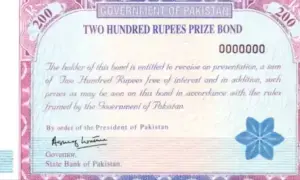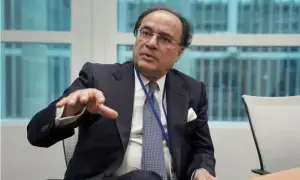China cuts interest rate in order to address faltering growth
 BEIJING: China delivered twin surprises on interest rates on Thursday, cutting borrowing costs to combat faltering growth while giving banks additional flexibility to set competitive lending and deposit rates in a step along the path of liberalization.
BEIJING: China delivered twin surprises on interest rates on Thursday, cutting borrowing costs to combat faltering growth while giving banks additional flexibility to set competitive lending and deposit rates in a step along the path of liberalization.
China's first rate cut since the global financial crisis underlined heightened concern among policymakers worldwide that the euro area's deepening debt problems are threatening economic growth.
Global shares rallied to their highest level in more than a week and the euro advanced on hopes that other major central banks would also take measures to shore up growth.
"It's obviously a very strong signal that the government wants to boost the economy, given the current weakness, especially in demand," stated Qinwei Wang, economist at Capital Economics in London.
The 25 basis points cut brings the official one year borrowing rate to 6.31 percent and the one year deposit rate to 3.25 percent.
The move confounded the call of many economists who thought the People's Bank of China (PBOC) would refrain from cutting policy rates this year despite wanting to support growth.
The European Union is China's single biggest foreign customer and faltering demand there has led to worries about the knock-on effect to domestic consumption if industrial activity slows dramatically.
A sudden collapse in global trade in late 2008 saw an estimated 20 million Chinese jobs axed in a matter of months and prompted Beijing to roll-out a 4 trillion yuan ($635 billion) fiscal stimulus plan to help bolster domestic economic activity.
While the cut to borrowing costs should help in the near term to shore up an economy on course for its weakest full year of expansion since 1999, it is the liberalization measure that is likely to have the greatest longer-term repercussions.
The PBOC said it was giving banks the freedom from June 8 to set deposit rates as high as 110 percent of the benchmark rate and offer rates on new loans for as little as 80 percent of official policy rates, an additional 10 percentage points from the current 90 percent limit.
Commercial banks until now have been barred from charging rates on deposits higher than the benchmark set by the central bank.
"It's a significant move," Wang said. "It's a first step in rate liberalization and it increases the returns for households. The lower floor for lending rates creates more competition between banks. So banks cannot guarantee their profits as before."
The moves, announced after financial markets closed in Asia, prompted rallies in stocks elsewhere.
World stocks as measured by the MSCI world equity index rallied to their highest levels in more than a week. The euro rose to $1.2625, its highest since late May.
Financial markets have rallied in the past two days on hopes for policy action to combat the potential impact of the euro zone debt crisis on the world economy.
Group of Seven financial leaders held an emergency conference call on Tuesday and Federal Reserve Chairman Ben Bernanke told Congress on Thursday the central bank stood ready to shield the U.S. economy from "significant risks" posed by Europe's debt and banking crisis.
GOOD AND BAD
Still, with a deluge of data due over the weekend that includes all of China's key barometers of investment and industrial activity, the rate changes raised concerns for some that the move was pre-empting grim news.
"The concern is that with industrial production and CPI data coming out of China at the weekend that it's indicative of them knowing something about weak data going forward," said Adrian Schmidt, currency strategist at Lloyds Bank in London.
The last change to the borrowing rate was in July 2011 when the 1-year benchmark lending rate was raised by 25 bps to 6.56 percent. The last rate cut was late in 2008.
The market consensus was for May's data to show signs of the economy stabilizing from a surprisingly weak April, albeit keeping it on course to deliver its weakest quarter of growth in three years.
The April data prompted an immediate easing of monetary conditions, with a cut to the required reserve ratio (RRR) at banks and a call from Premier Wen Jiabao that policymakers give "more priority to maintaining growth."
The PBOC has cut RRR for the biggest banks by 150 basis points from a record high of 21.5 percent in three moves since November last year, after a two-year tightening campaign to rein in inflation and cool steaming economic growth.
That has freed an estimated 1.2 trillion yuan ($190 billion) for new lending as authorities in Beijing have sought to stimulate economic activity without resorting to a major fiscal spending package like 2008's initiative.
Beijing is still tackling the after-effects of that program, which triggered a frenzy of real estate speculation, saw local governments amass 10.7 trillion yuan of debt and drove inflation to a three-year peak by July 2011.
ROOM FOR FURTHER EASING
The move to cut rates outright - wrong-footing most market analysts who had anticipated a further 100 bps of cuts in the RRR in the second half of 2012 but no cut to policy rates - likely signals China's belief that inflation is tame enough to take more aggressive easing steps.
This is a crucial point for Beijing, which wants to see growth solidly underpinned before a once-a-decade leadership change at the top of the ruling Communist Party, due towards the end of this year. It has been wary about setting off a fresh round of price hikes that could put social stability at risk.
High inflation has preceded political tension in China in the past - something the government is desperate to avoid as the leadership change has already been complicated by the purge of populist politician Bo Xilai and the murder scandal surrounding his fall.
The liberalization move meanwhile signals that reformers are in the ascendant as the new leadership takes shape. (Reuters)














Comments are closed on this story.